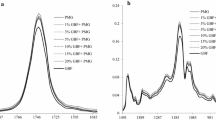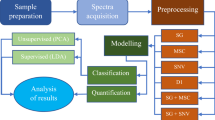Abstract
GC–MS and chemometric analysis of subcutaneous fat has been studied to classify three different feeding regimes of Iberian pigs. Nineteen fatty acids present in 57 fat samples were identified and quantified. Principal component analysis was employed for the preliminary study of the data structure. Discriminant analysis was used to classify samples into the three categories on the basis of the fatty acid profiles. Using a leave-one-out cross-validation procedure, only one fat sample from a pig fed with commercial feed, which simulated the fatty acid profile from free range animals, was incorrectly classified as having been fed on acorns and pasture. Using external validation, all of the samples were correctly classified. The most decisive fatty acids for distinguishing between groups, when using discriminant analysis were C16:1, C18:1, C17:0 and C18:0 for the first discriminant function, and C18:3, C14:0, C15:0, C22:0, C16:1 and C22:1 for the second discriminant function, ordered from the highest to the lowest coefficient. Some of the fatty acids important in distinguishing between groups are not the ones used by Spanish legislation to classify pigs in the different feeding categories. The results in this paper demonstrate the potential of statistical data treatment in the classification of animal feeding regimes.







Similar content being viewed by others
References
Lopez-Bote CJ (1998) Meat Sci 49:S17–S27. doi:10.1016/S0309-1740(98)00072-2
Ruiz J, Cava R, Antequera T, Martin L, Ventanas J, Lopez-Bote CJ (1998) Meat Sci 49:155–163. doi:10.1016/S0309-1740(97)00136-8
Rey AI, Lopez-Bote CJ, Arias RS (1997) Anim Sci 65:515–520
Cava R, Ruiz J, LopezBote C, Martin L, Garcia C, Ventanas J, Antequera T (1997) Meat Sci 45:263–270. doi:10.1016/S0309-1740(96)00102-7
Daza A, Rey AI, Ruiz J, Lopez-Bote CJ (2005) Meat Sci 69:151–163. doi:10.1016/j.meatsci.2004.06.017
Rey AI, Daza A, Lopez-Carrasco C, Lopez-Bote CJ (2006) Meat Sci 73:66–74. doi:10.1016/j.meatsci.2005.10.018
Muriel E, Ruiz J, Ventanas J, Antequera T (2002) Food Chem 78:219–225. doi:10.1016/S0308-8146(01)00401-0
Andres AI, Cava R, Mayoral AI, Tejeda JF, Morcuende D, Ruiz J (2001) Meat Sci 59:39–47. doi:10.1016/S0309-1740(01)00050-X
Wood JD, Richardson RI, Nute GR, Fisher AV, Campo MM, Kasapidou E et al (2004) Meat Sci 66:21–32. doi:10.1016/S0309-1740(03)00022-6
Sundrum A (2001) Livest Prod Sci 67:207–215. doi:10.1016/S0301-6226(00)00188-3
Morel PCH, McIntosh JC, Janz JAM (2006) Asian-Australas J Anim Sci 19:431–437
Boletin Oficial del Estado (2004) 283
Niñoles L, Clemente G, Ventanas S, Benedito J (2007) Meat Sci 76:102. doi:10.1016/j.meatsci.2006.10.018
Petron MJ, Muriel E, Tejeda JF, Ventanas J, Antequera T (2006) J Sci Food Agric 86:1040–1045. doi:10.1002/jsfa.2452
Petron MJ, Antequera T, Muriel E, Tejeda JF, Ventanas J (2004) Meat Sci 66:295–300. doi:10.1016/S0309-1740(03)00102-5
Petron MJ, Tejeda IF, Muriel E, Ventanas J, Antequera T (2005) Meat Sci 69:129–134. doi:10.1016/j.meatsci.2004.06.014
Ventanas S, Estevez M, Tejeda JF, Ruiz J (2006) Meat Sci 72:647–655. doi:10.1016/j.meatsci.2005.09.011
Rey AI, Isabel B, Cava R, Lopez-Bote CJ (1998) Can J Anim Sci 78:441–443
Tejeda JF, Antequera T, Ruiz J, Cava R, Ventanas J, Garcia C (1999) Food Sci Technol Int 5:229–233. doi:10.1177/108201329900500305
Pastorelli G, Magni S, Rossi R, Pagliarini E, Baldini P, Dirinck P et al (2003) Meat Sci 65:571–580. doi:10.1016/S0309-1740(02)00250-4
Petron MJ, Muriel E, Timon ML, Martin L, Antequera T (2004) Meat Sci 68:71–77. doi:10.1016/j.meatsci.2004.01.012
Acknowledgments
This work was partially supported by Spain’s Ministry of Science and Technology, within the framework of Project CTQ2004-01220 and Project BQU 2001-3615-C02/01. We are grateful to V. Valcárcel and M.J. Ayora for their help with the statistical studies. SLV also wishes to thank the Regional Government of Andalusia for granting a PhD fellowship. The authors wish to acknowledge to “Turcañada, S.L.” for providing the samples from Types 1 and 2.
Author information
Authors and Affiliations
Corresponding author
Rights and permissions
About this article
Cite this article
López-Vidal, S., Rodríguez-Estévez, V., Lago, S. et al. The Application of GC–MS and Chemometrics to Categorize the Feeding Regime of Iberian Pigs in Spain. Chroma 68, 593–601 (2008). https://doi.org/10.1365/s10337-008-0752-x
Received:
Revised:
Accepted:
Published:
Issue Date:
DOI: https://doi.org/10.1365/s10337-008-0752-x




